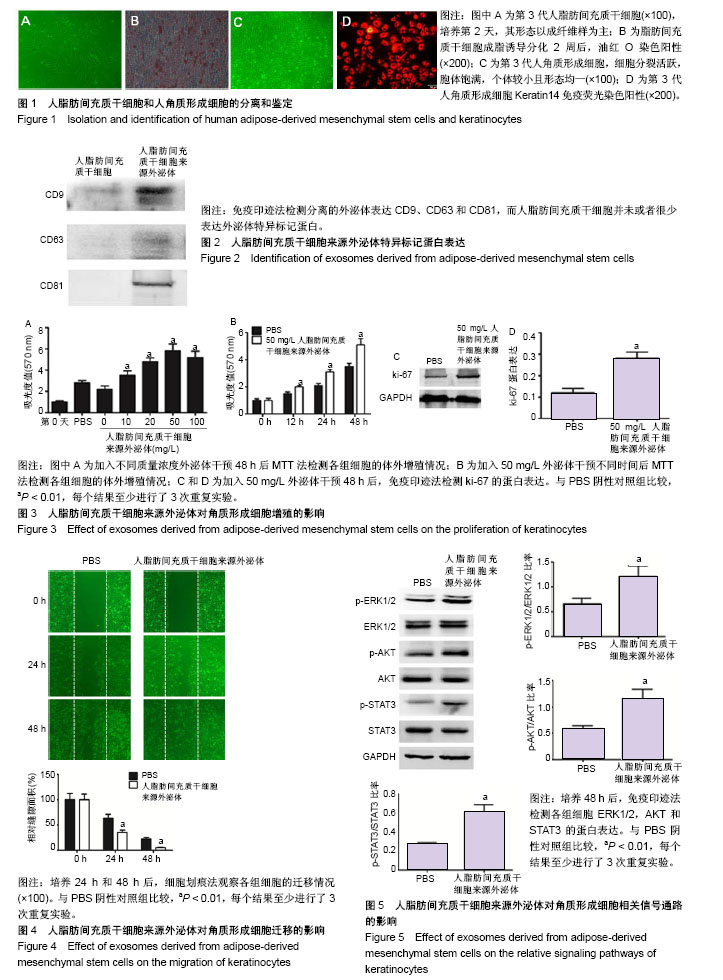| [1] Li W, Wu X, Gao C.Ten-year epidemiological study of chemical burns in Jinshan, Shanghai, PR China.Burns. 2013;39(7):1468-1473. [2] Blais M, Parenteau-Bareil R, Cadau S, et al. Concise review: tissue-engineered skin and nerve regeneration in burn treatment.Stem Cells Transl Med. 2013;2(7):545-551. [3] Spronk I, Legemate CM, Dokter J, et al. Predictors of health-related quality of life after burn injuries: a systematic review.Crit Care. 2018;22(1):160. [4] Mustoe TA, O'Shaughnessy K, Kloeters O.Chronic wound pathogenesis and current treatment strategies: a unifying hypothesis. PlastReconstr Surg. 2006;117(7 Suppl):35S-41S. [5] Raja, Sivamani K, Garcia MS,et al. Wound re-epithelialization: modulating keratinocyte migration in wound healing.Front Biosci. 2007;12:2849-2868. [6] Moura LI, Cruz MT, Carvalho E.The effect of neurotensin in human keratinocytes--implication on impaired wound healing in diabetes. ExpBiol Med (Maywood). 2014;239(1):6-12. [7] Taylor, Richard MI. Identification of M-CSF independent mechanisms of human osteoclast formation and analysis of the cellular and molecular mechanisms involved in tumourosteolysis. Voprosy Medit?sinsko? Khimii. 2011;11(5):22-26. [8] Pesce M, Patruno A, Speranza L, et al. Extremely low frequency electromagnetic field and wound healing: implication of cytokines as biological mediators.Eur Cytokine Netw. 2013;24(1):1-10. [9] Baum CL, Arpey CJ.Normal cutaneous wound healing: clinical correlation with cellular and molecular events. Dermatol Surg. 2005; 31(6):674-686. [10] Galiano RD, Tepper OM, Pelo CR, et al. Topical vascular endothelial growth factor accelerates diabetic wound healing through increased angiogenesis and by mobilizing and recruiting bone marrow-derived cells.Am J Pathol. 2004;164(6):1935-1947. [11] Jhamb S, Vangaveti VN, Malabu UH.Genetic and molecular basis of diabetic foot ulcers: Clinical review.J Tissue Viability. 2016;25(4):229-236. [12] Lerman OZ, Galiano RD, Armour M, et al. Cellular dysfunction in the diabetic fibroblast: impairment in migration, vascular endothelial growth factor production, and response to hypoxia.Am J Pathol. 2003; 162(1):303-312. [13] Teixeira FG, Carvalho MM, Neves-Carvalho A, et al. Secretome of mesenchymal progenitors from the umbilical cord acts as modulator of neural/glial proliferation and differentiation.Stem Cell Rev. 2015;11(2): 288-297. [14] Wilson JJ, Foyle KL, Foeng J, et al. Redirecting adult mesenchymal stromal cells to the brain: a new approach for treating CNS autoimmunity and neuroinflammation. Immunol Cell Biol. 2018;96(4):347-357. [15] Lee SH, Lee JH, Cho KH.Effects of Human Adipose-derived Stem Cells on Cutaneous Wound Healing in Nude Mice.Ann Dermatol. 2011;23(2):150-155. [16] Nambu M, Kishimoto S, Nakamura S, et al. Accelerated wound healing in healing-impaired db/db mice by autologous adipose tissue-derived stromal cells combined with atelocollagen matrix.Ann Plast Surg. 2009; 62(3):317-321. [17] Lee SH, Jin SY, Song JS, et al. Paracrine effects of adipose-derived stem cells on keratinocytes and dermal fibroblasts.Ann Dermatol. 2012; 24(2):136-143. [18] Vlassov AV, Magdaleno S, Setterquist R, et al. Exosomes: current knowledge of their composition, biological functions, and diagnostic and therapeutic potentials. Biochim Biophys Acta. 2012;1820(7):940-948. [19] Aryani A, Denecke B.Exosomes as a Nanodelivery System: a Key to the Future of Neuromedicine. MolNeurobiol. 2016;53(2):818-834. [20] Valadi H, Ekström K, Bossios A, et al. Exosome-mediated transfer of mRNAs and microRNAs is a novel mechanism of genetic exchange between cells.Nat Cell Biol. 2007;9(6):654-659. [21] Li Z, Wang Y, Xiao K, et al. Emerging Role of Exosomes in the Joint Diseases.Cell Physiol Biochem. 2018;47(5):2008-2017. [22] Schorey JS, Bhatnagar S.Exosome function: from tumor immunology to pathogen biology.Traffic. 2008;9(6):871-881. [23] Zhang W, Zhou X, Yao Q, et al. HIF-1-mediated production of exosomes during hypoxia is protective in renal tubular cells.Am J Physiol Renal Physiol. 2017;313(4):F906-F913. [24] Li T, Yan Y, Wang B, et al. Exosomes derived from human umbilical cord mesenchymal stem cells alleviate liver fibrosis.Stem Cells Dev. 2013;22(6):845-854. [25] Zhang Y, Chopp M, Liu XS, et al. Exosomes Derived from Mesenchymal Stromal Cells Promote Axonal Growth of Cortical Neurons. Mol Neurobiol. 2017;54(4):2659-2673. [26] Akita S, Akino K, Hirano A.Basic Fibroblast Growth Factor in Scarless Wound Healing.Adv Wound Care (New Rochelle). 2013;2(2):44-49. [27] Bruno S, Grange C, Deregibus MC, et al. Mesenchymal stem cell-derived microvesicles protect against acute tubular injury.J Am Soc Nephrol. 2009;20(5):1053-1067. [28] Vella LJ, Sharples RA, Nisbet RM, et al.The role of exosomes in the processing of proteins associated with neurodegenerative diseases. Eur Biophys J. 2008;37(3):323-332. [29] Herrera MB, Fonsato V, Gatti S, et al. Human liver stem cell-derived microvesicles accelerate hepatic regeneration in hepatectomized rats.J Cell Mol Med. 2010;14(6B):1605-1618. [30] Peinado H, Ale?kovi? M, Lavotshkin S, et al. Melanoma exosomes educate bone marrow progenitor cells toward a pro-metastatic phenotype through MET.Nat Med. 2012;18(6):883-891. [31] Atay S, Banskota S, Crow J, et al. Oncogenic KIT-containing exosomes increase gastrointestinal stromal tumor cell invasion.Proc Natl Acad Sci U S A. 2014;111(2):711-716. [32] Lai RC, Arslan F, Lee MM, et al. Exosome secreted by MSC reduces myocardial ischemia/reperfusion injury.Stem Cell Res. 2010;4(3):214-222. [33] Xin H, Li Y, Cui Y, et al. Systemic administration of exosomes released from mesenchymal stromal cells promote functional recovery and neurovascular plasticity after stroke in rats.J Cereb Blood Flow Metab. 2013;33(11):1711-1715. [34] Zhu YG, Feng XM, Abbott J, et al. Human mesenchymal stem cell microvesicles for treatment of Escherichia coli endotoxin-induced acute lung injury in mice.Stem Cells. 2014;32(1):116-125. [35] Shabbir A, Cox A, Rodriguez-Menocal L, et al. Mesenchymal Stem Cell Exosomes Induce Proliferation and Migration of Normal and Chronic Wound Fibroblasts, and Enhance Angiogenesis In Vitro.Stem Cells Dev. 2015;24(14):1635-1647. [36] Nishikai-Yan Shen T, Kanazawa S, Kado M, et al. Interleukin-6 stimulates Akt and p38 MAPK phosphorylation and fibroblast migration in non-diabetic but not diabetic mice. PLoS One. 2017;12(5):e0178232. [37] Wang C, Zhang Z, Xu T, et al. Upregulating mTOR/ERK signaling with leonurine for promoting angiogenesis and tissue regeneration in a full-thickness cutaneous wound model.Food Funct. 2018;9(4):2374-2385. [38] Sun Q, Rabbani P, Takeo M, et al. Dissecting Wnt Signaling for Melanocyte Regulation during Wound Healing.J Invest Dermatol. 2018;138(7):1591-1600. [39] Hsiao CM, Wu YS, Nan FH, et al. Immunomodulator 'mushroom beta glucan' induces Wnt/β catenin signalling and improves wound recovery in tilapia and rat skin: a histopathological study.Int Wound J. 2016;13(6):1116-1128. [40] Rosca AM, Rayia DM, Tutuianu R.Emerging Role of Stem Cells - Derived Exosomes as Valuable Tools for Cardiovascular Therapy.Curr Stem Cell Res Ther. 2017;12(2):134-138. |
.jpg)

.jpg)